The Power of Color: How Color Theory Shapes Marketing and Design
2 Minute Read
Color theory is fundamental in marketing. It has the power to convey messages, influence consumer psychology, and spark brand recognition. Examining the key roles of color theory is crucial for both marketers and creatives, as it directly impacts a brand’s ability to create effective visual communications. With even a basic understanding of color theory, marketers and creatives can make targeted visual content that increase sales. Here’s what you should know…
Color Attracts Attention
Most are already aware of the fact that color is one of the first things that catches someone’s attention when looking at an advertisement. Bold, bright colors can make a design stand out, which is why you’ll often see a “SALE” advertised in the color red. Alternatively, you could bring in an intentionally unexpected color to disrupt from the usual. This strategy serves as a way to differentiate a brand from its competition.
Color Adds Personality to Brand Identity
Color plays a substantial part in molding a brand identity. Consistent color use in a brand’s logo, website, and advertising works in a business’s best interest – it establishes brand recognition and builds brand loyalty. Consumers detect how playful, serious, accessible, or exclusive a brand is by its color palette. Ultimately, color should anchor a brand’s personality to help it become visually recognizable over time.
Color Conveys Emotion
Colors can instill specific emotions. Even though the mechanisms behind color psychology may still be unclear, it is proven that humans are affected by them subconsciously. Designers and marketers should consider the basic psychology in order to convey an intended feeling (and avoid conveying the wrong one). In an emotional sense, bright warm colors tend to be associated with opportunity, excitement, and danger – while cooler colors can signal a trustworthy, safe environment. A certain color choice can leave an audience feeling a sense of either urgency or calmness.
Color Enhances Usability
Using appropriate color schemes can boost the usability of a product or website. For example, using a high-contrast color scheme can make it easier for people with visual impairments to read text, and using contrasting colors in a design can make buttons and calls to action stand out more. Designers should be cautious of color choice for this reason, because it can also affect the way users perceive functionality. Usability should be top-of-mind when selecting colors for a seamless reading experience.
Whether you’re designing a logo, website, or advertising campaign, color is an essential component that should not be overlooked. So, go ahead and experiment with color – you never know how it might impact your brand’s success!

